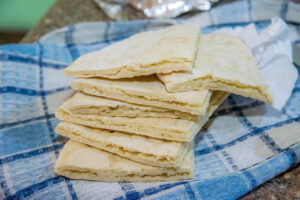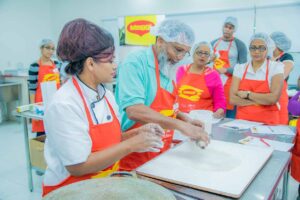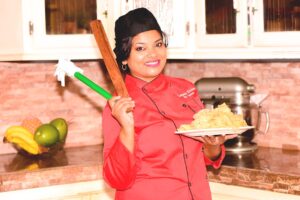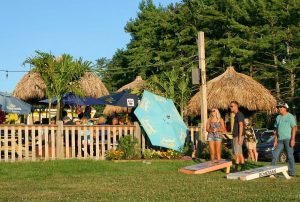Tucked away in the southernmost corner of the Caribbean Sea on the island of Trinidad, Lystra Seepersad, creator of the Caribbean Kitchen Pool & Lounge, teaches cooking to her fellow islanders and visitors. About 45 minutes from the twin island republic’s capital city Port of Spain, her home is a food oasis fed by a small but mighty kitchen garden producing sweet corn, broccoli, peppers and myriad of other vegetables, as well as spices such as karapule, which is used in curry.

At the center of her pool resides a white and pink blow up unicorn, a testament to her unique style and a favorite when she holds birthday parties for local children.
Lystra has spent the past two decades teaching herself to cook the specialties and varied cuisine of the islands and now shares what she’s learned through in-person and virtual classes. Mastering the diversity of Trinidadian and Tobagonian food can take years.
Like other Caribbean countries, recipes are rarely written down and instead are passed from generation to generation, much like family heirlooms. Lystra began experimenting with different spices at 19, and when she married, her husband Aftab was her guinea pig for taste testing. He was a gentle reminder that she could always improve. “Aftab might say that needs a little bit of this and that, but if he didn’t like the food he wouldn’t have said much, just not taken more,” she explains.
The cuisine of Trinidad and Tobago is “a melting pot formed from an array of cultures including Chinese, Indian, African, Syrian, Lebanese, Guyanese, Italian and Creole. Slaves, indentured servants and colonizers from Spain, France and Great Britain have also influenced the course of its cuisine for centuries.”
Lystra, who labels herself an “exquisite entrepreneur,” has done well helping others learn to cook the food of her homeland. Between her private group page and business pages on Facebook she has close to 100,000 followers who keep coming back in part because of the constant stories about food amidst photos of mouth-watering dishes and happy cooks in training.
One of her favorite ways of getting attention is to ask her followers what’s for dinner? The question is followed by images of delectable dishes such as palau, a stew made with either beef or chicken. Its unique flavor comes from searing the meat in caramelized sugar then simmering with rice, coconut milk and pigeon peas accompanied by slices of tomato, avocadoes or cucumber. Other meals may include curried duck or curried goat so tantalizing you can almost smell them through the Internet.
Preparing Meals in Paradise
Trinidad and Tobago, and the 21 smaller islands spanning almost 2,000 square miles off the coast of Venezuela, are worth a trip simply for the views. Trinidad is the more developed of the two big islands, and its capital Port of Spain is home to a thriving oil industry and one of the busiest shipping hubs in the Caribbean. By contrast, Tobago is largely undeveloped with a coastline encircled by peacock blue water and white coral sand beaches. Its interior is rich with rainforests, waterfalls and wildlife.

Lystra taught her first cooking class in 2017, a hands-on West Indian roti and curry workshop. Roti is a local wheat- based flatbread that can be compared to naan in India although the only version called sada roti has the similar buttery texture of the Indian version.
A local favorite roti is called Buss Up Shut because the crust is flaky and easily shreds, which looks like a bussed up or torn shirt. Street food such as Doubles, a sandwich made from curried chickpeas tucked between two pieces of fried flat bread and dressed in tamarind, coriander sauces and mango chutney, is also on the menu.
A typical cooking class lasts five to six hours and walks students through the process of preparing, cooking and presenting the finished meal. Students assist her in cooking, and when all is done each goes home with a box of food and a gift for coming to class, such as a special bowl or kitchen tongs. Lystra also travels to the students’ homes and prepares food with them in domiciles as varied as boats and corporate offices.

What’s the best part about teaching others to love the food of her native land? “I like it when my participants message me with their photos to show their progress in the kitchen,” she said. “Some have even opened catering businesses. I remember one participant who said his money for his wife’s classes was well worth it. That was a great feeling knowing I had helped others regain their confidence in the kitchen.” For more, go to caribbeankitchenbylystra.com
Whole Wheat Sada Roti
Ingredients
- 4 CUPS FLOUR
- 1⁄2 CUP WHEAT BRAN (OPTIONAL; COULD BE REPLACED WITH WHITE FLOUR)
- 3 TEASPOONS BAKING POWDER
- 3⁄4 TEASPOON SALT
- 1⁄2 TEASPOON SUGAR
- 11⁄2 TO 2 CUPS OF WATER FOR KNEADING
Method
- Place dry ingredients in a bowl, then knead flour with 11⁄2 cups of water, add a little more if necessary.
- Brush the top with oil, cover and leave to rest for 45 minutes.
- Make 3 to 4 small dough balls (loyas). Cover and leave to rest another 15 minutes.
- Heat the tawah or griddle.
- Open one of the dough balls and place on a floured surface. Roll out with a rolling pin about 8 inches wide and 1⁄2 inch thick.
- Place the rolled-out dough on the heated tawah. As soon as the bubbles start to form flip it over and cook the other side. Flip one more time.
- To sakay the roti (toast the edges so it inflates and you can put cooked vegetables inside), pull the tawah away from the flame, tilt the side you are holding downward so the side that is used is not touching your grill and use a clean dish cloth to push the roti towards the flame to cook the edges evenly.





